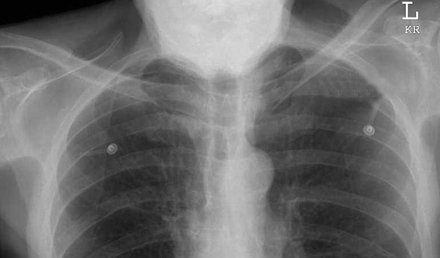A 32-year-old man with a history of pneumothorax presents to the urgent care after a sudden onset of left-sided chest pain that started 30 minutes earlier when he was inhaling while smoking a cigarette. He reports shortness of breath, dizziness, and diaphoresis. View the image taken (Figure 1) and consider what your diagnosis would be.
Read MoreGeneralized Abdominal Pain with Nausea
A 67-year-old man presents, reporting constipation that has lasted 3 days. He has a constant, generalized dull abdominal pain that is intermittently worse, occurring in what he describes as waves. He has nausea and reports that he has vomited once. He reports no blood in the urine or stool, and no weight loss, dysuria or urinary frequency, or dizziness. View the image taken (Figure 1) and consider what your diagnosis would be. Differential Diagnoses Small …
Read MoreAnkle Injury Sustained During an Amateur Football Game
A 25-year-old man presents to the urgent care center after a backyard game of football in which he twisted his ankle. Because of alcohol intoxication, he cannot remember the mechanism of injury. He reports isolated right ankle pain and is unable to bear weight. On physical examination, he has pain with palpation of the ankle, but there are no gross signs of deformity. An ankle x-ray has already been done by the time you see …
Read More
Chronic Cough and Shortness of Breath
A 74-year-old man without a significant past medical history presents to an urgent care center reporting 3 days of coughing productive of green sputum, shortness of breath that worsens with exertion, and chills. He says he has a chronic morning cough but states that the sputum has changed color and that his dyspnea has increased. He says he has not had any fever, chest pain, or lower extremity pain or swelling. View the image taken …
Read MoreAbstracts in Urgent Care: February, 2016
SEAN M. McNEELEY, MD Azithromycin Versus Doxycycline for Chlamydia Key point: Azithromycin is a little less effective than doxycycline for chlamydia. Citation: Geisler WM, Uniyal A, Lee JY, et al. Azithromycin versus doxycycline for urogenital Chlamydia trachomatis infection. N Engl J Med. 2015;373:2512–2521. This study of a population in a youth correctional facility compared the effectiveness of azithromycin with doxycycline in the treatment of chlamydia. A total of 567 participants were randomized to regimens of …
Read More
Shin Pain
Urgent message: Lower extremity injuries are very common in adolescent athletes. Urgent care providers must remember that shin pain is not always simply shin splints. CHRISTOPHER TANGEN, DO, and RYAN SHILIAN, DO Also known as medial tibial stress syndrome, shin splints are described as the painful inflammation of the tibial periosteum, which is generally caused by repetitive physical activity.1 Repetitive injuries can cause incomplete fractures, or microfractures, of the tibia. These tibial stress reactions can predispose the bone to acute fractures. Case Presentation …
Read More
Urgent Care Management of Geriatric Falls
Urgent message: Falls are a common reason for geriatric patients to present for medical care. In this population, even seemingly minor falls can lead to significant injury, and falls may occur in the first place because of serious underlying medical illnesses. It is critical for the urgent care provider to distinguish which of these patients can be treated in the urgent care setting and which require transfer to a higher level of care. REBEKAH BLICKENDORF, …
Read MoreProvider Credentialing: An 800-Pound Gorilla
Credentialing has become a recurring nightmare for physicians of all specialties, in every state and in every practice setting. Eager for a fresh start, and energized by new opportunity, we decide to make a job change. Recruiters colorfully praise these openings, as if every job pays more than our current one, is closer to parks and culture, and exists in a region with a lower cost of living and, of course, better weather. After a …
Read MoreShoulder Injury During Football Game
An 11-year-old boy presents with pain over the right clavicle that developed the previous day while he was playing football and another player fell on him. He has pain with range of motion of the right shoulder as well as with movement of the torso. He has no shortness of breath, chest pain, dizziness, or numbness of the arm. View the image taken (Figure 1) and consider what your diagnosis would be.
Read MoreAbstracts in Urgent Care: January, 2016
SEAN M. McNEELEY, MD When Accuracy Is a Must, Go for Central Thermometers Key point: Peripheral thermometers are not nearly as accurate as central thermometers. Citation: Niven DJ, Gaudet JE, Laupland KB, et al. Accuracy of peripheral thermometers for estimating temperature: a systematic review and meta-analysis. Ann Intern Med. 2015; 163:768–777. Temperature measurement is performed at most visits to urgent care centers. Although the data are not always important in clinical decision-making, sometimes they are …
Read More